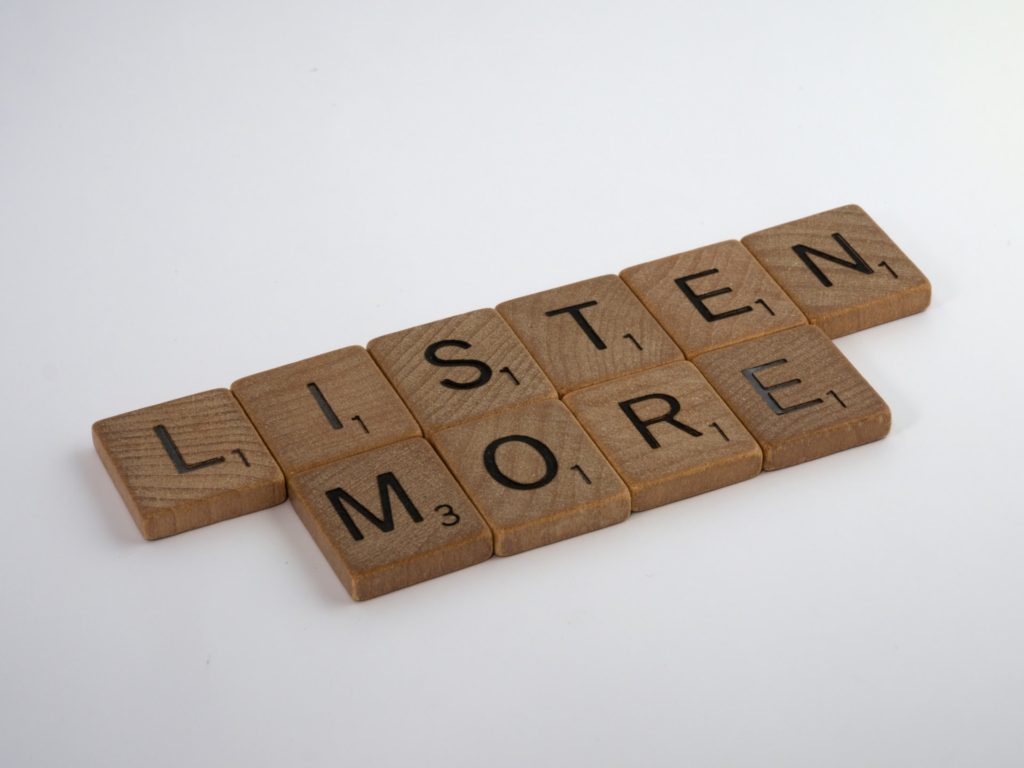At some point in my life, I heard the saying, “we have two ears and one mouth for a reason” and “when we listen to hear, we are not planning our response”. Yet over time, I’ve come to appreciate “learn to listen and listen to learn” as the reminder phrase to listen closely, with compassion and to learn something.
Listening is how we make sense of, assess and respond to what we hear. “There is a difference between truly listening and waiting for your turn to talk.” —Ralph Waldo Emerson.

What is Active Listening?
Active Listening
- There are five steps to active listening; receiving, understanding, evaluating, remembering and responding
- An active listener provides feedback on what was heard
- Critical thinking skills are linked to listening (critical thinking involves qualitatively and quantitatively assessing information gathered)
Causes of Poor Listening
- Distractions
- Difficulty prioritizing information
- Low concentration ability
- When we think we know everything about the topic
- Confusion about the topic
- Focus on the “style” of the speaker, vs. the content
Active Listening Techniques
- Trust building and rapport building
- Display empathy/concern
- Paraphrase to show understanding
- Show understanding using non-verbal cues such as nodding, eye contact, and leaning forward
- Brief verbal affirmations like “I see,” “I know,” “Sure,” “Thank you,” or “I understand”
- Ask questions to clarify or affirm
- Show understanding using personal examples
There are other techniques that involve Emotional Intelligence (EQ). Situational awareness scores high on the list. Being sensitive to others and realizing the experiences of others may not be anything like ours is so important. When we listen to learn, we’re open to discovering new perspectives, ideas and thoughts.
Psychology Today wrote an article June 2, 2020 with these tips about how to be an active listener and what to avoid. https://www.psychologytoday.com/us/blog/in-it-together/202006/active-listening-skills
How to be an active listener
1. Listen without making judgments or taking a position on an issue. Gain an understanding of the situation from the other’s point of view.
2. Allow the speaker to finish thoughts without interruption. This usually includes brief periods of silence, such as a few seconds. It may take some practice before being able to know how long to wait before making some type of response. If unsure, it is always better to wait too long rather than speak too soon and interrupt the speaker’s thoughts.
3. Show that your attention is focused. Make eye contact, lean in towards the speaker when your interest peaks, and share any humor with a smile or other natural response.
4. Repeat what you have heard to check for accuracy. Use the speaker’s exact words when in doubt that you have heard accurately; more often, it is better to paraphrase what was said.
5. Ask questions as needed when you don’t understand what the speaker is trying to communicate, particularly when you’re trying to grasp the main point of their statement.
6. Give a short summary to indicate that you have heard and understood what was said.
7. Optional: As the final step, but not sooner, you may choose to share similar situations that you’ve experienced or your own views about the issue. You may even share a completely different opinion than that expressed, as long as that sharing is done after you have understood what was communicated to you.
“The biggest communication problem is we do not listen to understand. We listen to reply.” —Stephen R. Covey, author of The 7 Habits of Highly Effective People.
What to avoid during active listening
1. Interrupting a sentence. Even if there is a long pause, one should first encourage the completion of the thought by the speaker.
2. Failing to make eye contact. Breaks from eye contact are normal and expected, but a total lack of eye contact communicates a lack of attention.
3. Rushing the speaker. This can be a challenge, particularly when the speaker goes into excessive or unrelated details to tell their story. Do your best to politely encourage them to move along with the point.
4. Getting distracted by other thoughts, or events nearby, and losing focus. Daydreaming while pretending to listen is probably only going to frustrate the speaker.
5. Over focus upon certain details, or asking about minor details that distract from the speaker’s point.
6. Changing the subject abruptly. This includes interjecting an account of “something similar that happened to me.”
7. Making jokes or sarcastic comments which distract from the points being made. Save the humor for later in the conversation.
8. Listening to decide what your reply should be. This is a common risk when the speaker is expressing a complaint and the listener begins to feel defensive. The natural tendency would be to shift focus to “how will I defend myself from this accusation?” or “how will I prove them wrong?” If you have actively listened, you may learn that you don’t need to defend yourself. Your partner may not be blaming you for anything. If blame has been thrown at you, you will have your chance to speak your own thoughts after you’ve listened to the complaint.

Consider listening to learn, and take time to listen as we approach year end. This year is teaching us so much. How about a healthy dose of optimism moving forward?
It’s a good time to plan for Q1 2021. When you want to talk about taking care of business at home and work, contact me via Email or check out the website @ The Living Planner for additional information.
If I may be of assistance, reach out. Stay well –Lynn
#LifeAndBusinessIntersect #CareForPeopleCareForBusiness #StepUpStepIn
